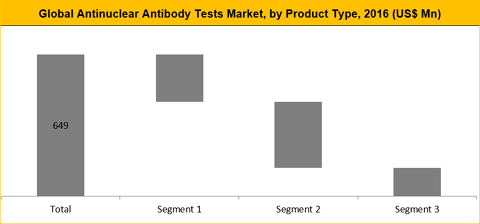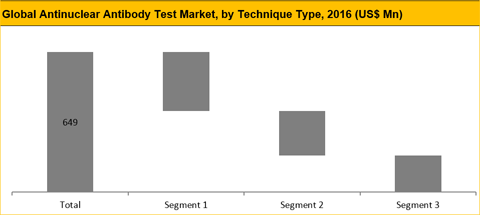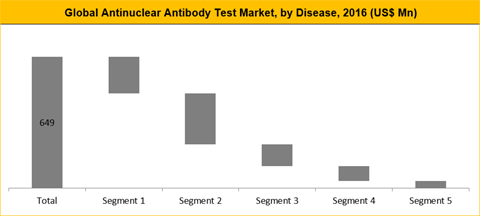
According to the American Autoimmune Related Diseases Association (AARDA), autoimmune diseases affect around 50 million Americans. It is considered as one of the leading causes of mortality in young and middle-aged women in the United States. An autoimmune disease occurs when body’s own cells are identified as foreign element and immune system reacts against to its “self” cell. Antibody testing is used to evaluate this disorder that affect tissues and organs throughout systemic body. The global anti-nuclear antibody (ANA) testing market exhibits rapid growth due to rising prevalence of autoimmune disorder and demand for advanced test kits. Availability of novel biomarkers and high adoption rate of multiplex assay kits further fuels the demand of global antinuclear antibody testing market.
The report titled “Antinuclear Antibody Tests Market - Growth, Future Prospects and Competitive Analysis, 2021–2029” offers strategic insights into the overall antinuclear antibody test market along with the market size and estimates for the duration 2019 to 2029. The said research study covers in-depth analysis of multiple market segments based on type of product, technique, disease and different geographies. The product types studied for analyzing the overall global antinuclear antibody test market are majorly segmented into reagent & assay kits, software & services and systems. The global antinuclear antibody tests market is segmented by technique type into ELISA, immunofluorescence assay and multiplex assay. By disease, global antinuclear antibody tests market is segmented into rheumatoid arthritis, systemic lupus erythematosus, sjögren’s syndrome, scleroderma and other diseases.
Market size and forecast for these regional and country level markets are presented in this study for the period 2019-2029. Market growth rates for the forecast period 2021-2029 are also included in this report, considering 2020 as the base year. Further cross-sectional presented in terms of product, technique, disease and constituent region/country level markets is also included in this section.
Along with quantitative information, qualitative information sets and assessment tools are provided in this study for better analysis of the overall market scenario and future prospects. Information such as market drivers, challenges and opportunities assists the readers for understanding the ongoing trends in the global antinuclear antibody tests market. Tools such as market positioning of key players and attractive investment proposition provide the readers with insights on the competitive scenario of the global antinuclear antibody tests market. This report concludes with company profiles section that highlights major information about the key players engaged in global antinuclear antibody tests market. In-depth competitive environment analysis and historical (2019) market size data are also provided in the report.
Furthermore, this report concludes with profiling of key market players currently enjoying prominent position in the vascular grafts market. The key players profiled in this report are Alere Inc., EUROIMMUN AG, ERBA Diagnostics, Inc., Trinity Biotech plc, Bio-Rad Laboratories, Inc., Immuno Concepts, Thermo Fisher Scientific,Inc., Antibodies,Inc., Inova Diagnostics, Zeus Scientific, Inc. and others.
Based on the type of products, the global antinuclear antibody tests market is segmented as follows:
In 2020, reagents and assay kits occupy the largest share of global antinuclear antibody test market. Growth in this segment is observed due to rise in prevalence of autoimmune disease and reagent rental agreements. Clinical laboratories are benefitting from reagent rentals and cost per test contracts in terms of cost containment that would further help them to buy new instruments. In the recent years, multiplex ANA kits have evolved as the most convenient method and led to faster diagnosis outcomes.

Based on the type of techniques, the global antinuclear antibody tests market is segmented as follows:
There is increase in trend observed in autoimmune disorders, mainly due to awareness about the disease and improved diagnostic tools. Enzyme-Linked Immunosorbent Assay (ELISA) dominates the global antinuclear antibody test market. Two most common ANA screening tests - indirect immunofluorescence and ELISA are frequently practiced in commercial labs. Though ELISA is most frequently used, there is a paradigm shift observed towards usage of multiplex immunoassays. High adoption of multiplex immunoassays by companies and laboratories drives the fast growth of this segment.

Based on the type of diseases, the global antinuclear antibody tests market is segmented as follows:
Lately, the prevalence of autoimmune diseases, particularly in developed countries has increased exponentially. Rapid rise in autoimmune disease prevalence is associated with major environmental factors such as infection, ecology and nutrition. Rheumatoid arthritis occupies the largest revenue share of the global antibody tests market due to rising prevalence of rheumatoid arthritis. According to WHO studies, prevalence of rheumatoid arthritis ranges from 0.3%-1% and commonly observed in women and developed countries. According Lupus Foundation of America study, around 1.5 Mn American suffer from Lupus and at least 5 Mn across the world.

In 2020, North America dominated the global antinuclear antibody tests market followed by Europe. Rising incidence of autoimmune diseases, increasing healthcare expenditure, extensive research and development for novel biomarkers, and favorable reimbursement policies, are some of the major factors that fuel the growth of antinuclear antibody tests market in North America. Around 3% population in U.S. are affected by autoimmune disorders. Asia Pacific is anticipated to be the fastest growing market in the forecast period 2021-2029. Increase in incidence of chronic autoimmune diseases such as rheumatoid arthritis, rising awareness about disease and improved diagnostics technology, improving healthcare infrastructure and government funding are contributing to the growth of antinuclear antibody tests market in Asia Pacific.
Historical & Forecast Period
This study report represents analysis of each segment from 2022 to 2032 considering 2023 as the base year. Compounded Annual Growth Rate (CAGR) for each of the respective segments estimated for the forecast period of 2024 to 2032.
The current report comprises of quantitative market estimations for each micro market for every geographical region and qualitative market analysis such as micro and macro environment analysis, market trends, competitive intelligence, segment analysis, porters five force model, top winning strategies, top investment markets, emerging trends and technological analysis, case studies, strategic conclusions and recommendations and other key market insights.
Research Methodology
The complete research study was conducted in three phases, namely: secondary research, primary research, and expert panel review. key data point that enables the estimation of Antinuclear Antibody Testing (ANA) market are as follows:
Market forecast was performed through proprietary software that analyzes various qualitative and quantitative factors. Growth rate and CAGR were estimated through intensive secondary and primary research. Data triangulation across various data points provides accuracy across various analyzed market segments in the report. Application of both top down and bottom-up approach for validation of market estimation assures logical, methodical and mathematical consistency of the quantitative data.
| ATTRIBUTE | DETAILS |
|---|---|
| Research Period | 2022-2032 |
| Base Year | 2023 |
| Forecast Period | 2024-2032 |
| Historical Year | 2022 |
| Unit | USD Million |
| Segmentation | |
Product
| |
Technique
| |
Disease
| |
|
Region Segment (2022-2032; US$ Million)
|
Key questions answered in this report